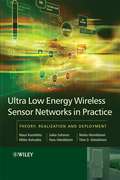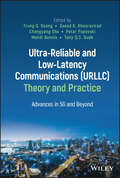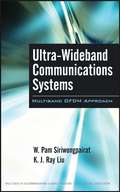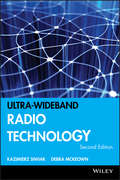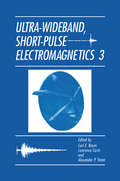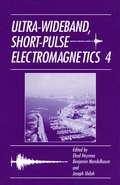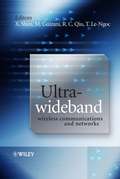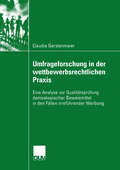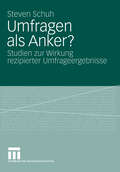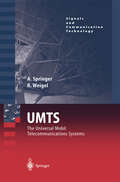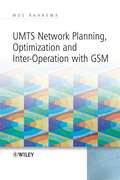- Table View
- List View
Ultra-high Frequency Linear Fiber Optic Systems (Springer Series in Optical Sciences #159)
by Kam Y. LauThis book provides an in-depth treatment of both linear fiber-optic systems and their key enabling devices. It presents a concise but rigorous treatment of the theory and practice of analog (linear) fiber-optics links and systems that constitute the foundation of Hybrid Fiber Coax infrastructure in present-day CATV distribution and cable modem Internet access. Emerging applications in remote fiber-optic feed for free-space millimeter wave enterprise campus networks are also described. Issues such as dispersion and interferometric noise are treated quantitatively, and means for mitigating them are explained. This broad but concise text will thus be invaluable not only to students of fiber-optics communication but also to practicing engineers. To the second edition of this book important new aspects of linear fiber-optic transmission technologies are added, such as high level system architectural issues, algorithms for deriving the optimal frequency assignment, directly modulated or externally modulated laser transmitters and the use of Erbium-doped fiber amplifier (EDFA) in linear fiber optic systems. Significant examples of field deployed military systems enabled by linear fiber optic links are described in an appendix.
Ultra-Low Energy Wireless Sensor Networks in Practice: Theory, Realization and Deployment
by Mauri Kuorilehto Mikko Kohvakka Jukka Suhonen Panu Hämäläinen Marko Hännikäinen Timo D. HamalainenFinally a book on Wireless Sensor Networks that covers real world applications and contains practical advice! Kuorilehto et al. have written the first practical guide to wireless sensor networks. The authors draw on their experience in the development and field-testing of autonomous wireless sensor networks (WSNs) to offer a comprehensive reference on fundamentals, practical matters, limitations and solutions of this fast moving research area. Ultra Low Energy Wireless Sensor Networks in Practice: Explains the essential problems and issues in real wireless sensor networks, and analyzes the most promising solutions. Provides a comprehensive guide to applications, functionality, protocols, and algorithms for WSNs. Offers practical experiences from new applications and their field-testing, including several deployed networks. Includes simulations and physical measurements for energy consumption, bit rate, latency, memory, and lifetime. Covers embedded resource-limited operating systems, middleware and application software. Ultra Low Energy Wireless Sensor Networks in Practice will prove essential reading for Research Scientists, advanced students in Networking, Electrical Engineering and Computer Science as well as Product Managers and Design Engineers.
Ultra-Low-Power and Ultra-Low-Cost Short-Range Wireless Receivers in Nanoscale CMOS (Analog Circuits and Signal Processing)
by Zhicheng Lin Pui-In Mak (Elvis) Rui Paulo MartinsThis book provides readers with a state-of-the-art description of techniques to be used for ultra-low-power (ULP) and ultra-low-cost (ULC), short-range wireless receivers. Readers will learn what is required to deploy these receivers in short-range wireless sensor networks, which are proliferating widely to serve the internet of things (IoT) for “smart cities.” The authors address key challenges involved with the technology and the typical tradeoffs between ULP and ULC. Three design examples with advanced circuit techniques are described in order to address these trade-offs, which special focus on cost minimization. These three techniques enable respectively, cascading of radio frequency (RF) and baseband (BB) circuits under an ultra-low-voltage (ULV) supply, cascading of RF and BB circuits in current domain for current reuse and a novel function-reuse receiver architecture, suitable for ULV and multi-band ULP applications such as the sub-GHz ZigBee.
Ultra-Low Power Wireless Technologies for Sensor Networks (Integrated Circuits and Systems)
by Brian Otis Jan RabaeyThis book is written for academic and professional researchers designing communication systems for pervasive and low power applications. There is an introduction to wireless sensor networks, but the main emphasis of the book is on design techniques for low power, highly integrated transceivers. Instead of presenting a single design perspective, this book presents the design philosophies from three diverse research groups, providing three completely different strategies for achieving similar goals. By presenting diverse perspectives, this book prepares the reader for the countless design decisions they will be making in their own designs.
Ultra-Reliable and Low-Latency Communications (URLLC) Theory and Practice: Advances in 5G and Beyond
by Trung Q. Duong Saeed R. Khosravirad Changyang She Petar Popovski Mehdi Bennis Tony Q. S. QuekUltra-Reliable and Low-Latency Communications (URLLC) Theory and Practice Comprehensive resource presenting important recent advances in wireless communications for URLLC services, including device-to-device communication, multi-connectivity, and more Ultra-Reliable and Low-Latency Communications (URLLC) Theory and Practice discusses the typical scenarios, possible solutions, and state-of-the-art techniques that enable URLLC in different perspectives from the physical layer to higher-level approaches, aiming to tackle URLLC’s challenges with both theoretical and practical approaches, which bridges the lacuna between theory and practice. With long-term contributions to the development of future wireless networks, the text systematically presents a thorough study of the novel and innovative paradigm of URLLC; basic requirements are covered, along with essential definitions, state-of-the-art technologies, and promising research directions of URLLC. To aid in reader comprehension, tables, figures, design schematics, and examples are provided to illustrate abstract engineering concepts and make the text more accessible to a broader readership, and corresponding case studies are included in the last part of the book. Fundamental problems in URLLC, including designing building blocks for URLLC, radio resource management in URLLC, resource optimization, network availability guarantee, and coexisting with other future mobile networks, are also discussed. In Ultra-Reliable and Low-Latency Communications (URLLC) Theory and Practice, readers can expect to find detailed information on: BCH and analog codes, stable matching, OFDM demodulation and turbo coding, and semi-blind receivers for URLLC MIMO-NOMA with URLLC, PHY and MAC layer technologies for URLLC, and Network slicing or SDN for URLLC and eMBB Integrating theoretical knowledge into deep learning for URLLC, Energy-Latency tradeoff in URLLC, and Downlink transmission for URLLC under physical layer aspects Resource allocation for multi-user downlink URLLC, HARQ optimization for 5G URLLC, and Multi-Access edge computing with URLLC A unique resource with comprehensive yet accessible coverage of a complicated subject, Ultra-Reliable and Low-Latency Communications (URLLC) Theory and Practice is an ideal resource for a large and diverse population of researchers and practitioners in engineering, computer scientists, and senior undergraduate and graduate students in related programs of study.
Ultra-Reliable and Low-Latency Communications (URLLC) Theory and Practice: Advances in 5G and Beyond
by Trung Q. Duong Saeed R. Khosravirad Changyang She Petar Popovski Mehdi Bennis Tony Q.S. QuekUltra-Reliable and Low-Latency Communications (URLLC) Theory and Practice Comprehensive resource presenting important recent advances in wireless communications for URLLC services, including device-to-device communication, multi-connectivity, and more Ultra-Reliable and Low-Latency Communications (URLLC) Theory and Practice discusses the typical scenarios, possible solutions, and state-of-the-art techniques that enable URLLC in different perspectives from the physical layer to higher-level approaches, aiming to tackle URLLC’s challenges with both theoretical and practical approaches, which bridges the lacuna between theory and practice. With long-term contributions to the development of future wireless networks, the text systematically presents a thorough study of the novel and innovative paradigm of URLLC; basic requirements are covered, along with essential definitions, state-of-the-art technologies, and promising research directions of URLLC. To aid in reader comprehension, tables, figures, design schematics, and examples are provided to illustrate abstract engineering concepts and make the text more accessible to a broader readership, and corresponding case studies are included in the last part of the book. Fundamental problems in URLLC, including designing building blocks for URLLC, radio resource management in URLLC, resource optimization, network availability guarantee, and coexisting with other future mobile networks, are also discussed. In Ultra-Reliable and Low-Latency Communications (URLLC) Theory and Practice, readers can expect to find detailed information on: BCH and analog codes, stable matching, OFDM demodulation and turbo coding, and semi-blind receivers for URLLC MIMO-NOMA with URLLC, PHY and MAC layer technologies for URLLC, and Network slicing or SDN for URLLC and eMBB Integrating theoretical knowledge into deep learning for URLLC, Energy-Latency tradeoff in URLLC, and Downlink transmission for URLLC under physical layer aspects Resource allocation for multi-user downlink URLLC, HARQ optimization for 5G URLLC, and Multi-Access edge computing with URLLC A unique resource with comprehensive yet accessible coverage of a complicated subject, Ultra-Reliable and Low-Latency Communications (URLLC) Theory and Practice is an ideal resource for a large and diverse population of researchers and practitioners in engineering, computer scientists, and senior undergraduate and graduate students in related programs of study.
Ultra Wideband: Circuits, Transceivers and Systems (Integrated Circuits and Systems)
by Ranjit Gharpurey Peter KingetThis book is a compilation of chapters on various aspects of Ultra Wideband. The book includes chapters on Ultra Wideband transceiver implementations, pulse-based systems and one on the implementation for the WiMedia/MBOFDM approach. Another chapter discusses the implementation of the physical layer baseband, including the ADC and post-ADC processing required in the UWB system. Future advances such as multiantenna UWB solutions are also discussed.
Ultra-wideband Coherent Optical LANs (Research Reports Esprit #1)
by S. ForcesiThe content of this book is the result of the work and the experiences of an interdisciplinary and strictly European group of researchers who have attempted to give birth to a new fibre communication network concept by exploiting the potential benefits of optical coherent transmission. The run towards this ambitious goal started in 1985 on the basis of the ESPRIT program incentives by an "ad hoc" consortium of industrial partners and research institutions. The first three years were dedicated to a feasibility study carried out by a reduced number of "pioneers". In 1989 the team was extended to eleven partners. There was already clear evidence of the increasing interest in Europe in exploring the actual limits of optical fibre coherent systems; the project had innovative and very advanced features that were gradually refined by incorporating the latest technological developments to which it has directly contributed. The main objective of the project targeted the development of the necessary building blocks to show experimentally the performance and the flexibility built into the proposed concept of multi-channel ultra-wideband network. The system concept developed within this project associates optical frequency division multiplexing with a suitable network architecture and management techniques to allow very high flexibility and efficiency in handling simultaneous transmission over the network (on each optical frequency) of multiple virtual channels each operating with a wide range of information rates ranging from a fraction of a Mb/s up to a maximum value in excess of 160 Mb/s.
Ultra-Wideband Communications Systems: Multiband OFDM Approach (Wiley - IEEE)
by W. Pam Siriwongpairat K. J. LiuThe only book that provides full coverage of UWB multiband OFDM technology Ultra-wideband (UWB) has emerged as a technology that offers great promise to satisfy the growing demand for low-cost, high-speed digital networks. The enormous bandwidth available, the potential for high data rates, and the promise for small size and low processing power with reduced implementation cost all present a unique opportunity for UWB to become a widely adopted radio solution for future wireless home networking technology. Ultra-Wideband Communications Systems is the first book to provide comprehensive coverage of the fundamental and advanced issues related to UWB technology, with a particular focus on multiband orthogonal frequency division multiplexing (multiband OFDM). The multiband OFDM approach was a leading method in the IEEE 802.15.3astandard and has recently been standardized by ECMA International. The book also explores several major advanced state-of-the-art technologies to enhance the performance of the standardized multiband OFDM approach. Additional coverage includes: * Characteristics of UWB channels * An overview of UWB single-band and multiband OFDM approaches * MIMO multiband OFDM * Performance characterization * Performance under practical considerations * Differential multiband OFDM * Power-controlled channel allocation * Cooperative UWB multiband OFDM Complete with pointers for future research opportunities to enhance the performance of UWB multiband OFDM technology over current and future wireless networks, this is an indispensable resource for graduate students, engineers, and academic and industrial researchers involved with UWB.
Ultra Wideband Demystified Technologies, Applications, and System Design Considerations (River Publishers Series In Communications Ser.)
by Sunil Jogi Manoj ChoudharyUltra Wideband Demystified: Technologies, Applications, and System Design Considerations is a comprehensive text for emerging high speed short range wireless technology of Ultra Wideband. It provides background concepts and information on evolving standards and their development efforts, radio technology, practical system design/implementation and real life applications. The book also deliberates on the regulatory frameworks, security aspects and power management techniques essential to Ultra Wideband usage in consumer devices like portable handheld mobile devices. Important topics as UWB common radio usage for adapting to different existing/new applications and upper layer protocols like Wireless USB are also discussed.ContentsAbstract :• Introduction to Short Range Wireless;• Introduction to Ultra Wideband;• Evolution of UWB Standards;• Physical Layer;• Medium Access Layer;• Advanced MAC Features;• UWB System Design;• Adaptation to Multiple Applications;• Wireless USB;• Converging Marketplace; ReferencesForeword"This book is very timely, unique and fresh in its approach, coming from engineers who have been involved in system design and standard development stages. In particular, the book stands out amongst other literature available because it highlights system designer's viewpoints and because of it covering the whole gamut of technology from practitioner's viewpoints ... I would strongly recommend this book to System Designers, Practicing Engineers, Researchers in Academia and Industry, Product Marketing and Technical strategists for a comprehensive reading on the emerging UWB technologies. I commend Sunil Jogi and Manoj Choudhary for a very timely contribution."Bart Vertenten Chief Architect Connectivity, NXP Semiconductors
Ultra Wideband Demystified Technologies, Applications, and System Design Considerations
by Sunil Jogi Manoj ChoudharyUltra Wideband Demystified: Technologies, Applications, and System Design Considerations is a comprehensive text for emerging high speed short range wireless technology of Ultra Wideband. It provides background concepts and information on evolving standards and their development efforts, radio technology, practical system design/implementation and real life applications. The book also deliberates on the regulatory frameworks, security aspects and power management techniques essential to Ultra Wideband usage in consumer devices like portable handheld mobile devices. Important topics as UWB common radio usage for adapting to different existing/new applications and upper layer protocols like Wireless USB are also discussed.ContentsAbstract :• Introduction to Short Range Wireless;• Introduction to Ultra Wideband;• Evolution of UWB Standards;• Physical Layer;• Medium Access Layer;• Advanced MAC Features;• UWB System Design;• Adaptation to Multiple Applications;• Wireless USB;• Converging Marketplace; ReferencesForeword"This book is very timely, unique and fresh in its approach, coming from engineers who have been involved in system design and standard development stages. In particular, the book stands out amongst other literature available because it highlights system designer's viewpoints and because of it covering the whole gamut of technology from practitioner's viewpoints ... I would strongly recommend this book to System Designers, Practicing Engineers, Researchers in Academia and Industry, Product Marketing and Technical strategists for a comprehensive reading on the emerging UWB technologies. I commend Sunil Jogi and Manoj Choudhary for a very timely contribution."Bart Vertenten Chief Architect Connectivity, NXP Semiconductors
Ultra-Wideband Radio Frequency Identification Systems
by Faranak Nekoogar Farid DowlaUltra-wideband Radio Frequency Identification Systems describes the essentials of radio frequency identification (RFID)systems as well as their target markets. The book covers a study of commercially available RFID systems and characterizes their performance in terms of read range and reliability in the presence of conductive and dielectric materials. The capabilities and limitations of commercial RFID systems are reported followed by comprehensive discussions of the advantages and challenges of using ultra-wideband (UWB) technology for tag/reader communications. The book presents practical aspects of RFID system such as: EPC global and ISO standards, implementation, and target markets in a simple and easy to understand language.
Ultra-wideband Radio Technology
by Kazimierz Siwiak Debra McKeownUltra-wideband (UWB) has been among the most controversial technologies of modern times. Its applications seem endless, its capabilities miraculous and yet it is so poorly understood. In this volume, the authors combine talents to de-mystify ultra-wideband radio and explain it in language that is accessible to non-technologists as well as technologists. They contrast UWB with conventional radio technology so that fundamental, technically accurate information devoid of specific technical and analytical details is accessible for marketing managers, business developers, engineering managers, technology managers, potential investors, financial analysts, executive recruiters, technical writers, and technologists from other fields. The authors also include enough specific technical and engineering information about UWB, for the seasoned technologists, engineers, scientists and academicians who need to understand the topic at an entry level. Provides simple high level, conceptual discussions of UWB followed with more detailed, scientific, mathematical, engineering focused explanations Presents a global perspective by tracing UWB throughout the history of radio, providing a modern basis for the re-emergence of the technology and for the current regulatory and standards activities Features insights into the reasons why the technology developed the way it did Explains the key advantages of UWB, including its bandwidth, potential simplicity and huge system capacity Discusses the applications of UWB in terms of the unique properties and advantages of UWB Ultra-wideband Radio Technology will inform, educate and inspire!...
Ultra-Wideband, Short-Pulse Electromagnetics 3
by Carl E. Baumann Lawrence Carin Alexander P. StoneThe first two international conferences on Ultra-Wideband (UWB), Short-Pulse (SP) Electromagnetics were held at Polytechnic University, Brooklyn, New York in 1992 and 1994. Their purpose was to focus on advanced technologies for generating, radiating, and detecting UWB,SP signals, on mathematical methods, their propagation and scattering, and on current as well as potential future applications. The success of these two conferences led to the desirability of scheduling a third conference. Impetus was provided by the electromagnetics community and discussions led by Carl Baum and Larry Carin resulted in the suggestion that the UWB conferences be moved around, say to government laboratories such as Phillips Laboratory. Consequently the decision was made by the Permanent HPEM Committee to expand AMEREM '96 to include the Third Ultra-Wide Band, Short-Pulse (UWB,SP 3) with the Third Unexploded Ordnance Detec tion and Range Remediation Conference (UXO) and the HPEMINEM Conference in Albuquerque, New Mexico during the period May 27-31, 1996. Planning is now underway for EUROEM '98 in June, 1998 in Tel Aviv, Israel. Joseph Shiloh is the conference chairman. A fourth UWB,SP meeting is planned as a part of this conference and Ehud Heyman will coordinate this part of the meeting. The papers which appear in this volume, the third in the UWB,SP series, update subject areas from the earlier UWB,SP conferences. These topics include pulse generation and detection, antennas, pulse propagation, scattering theory, signal processing, broadband electronic systems, and buried targets.
Ultra-Wideband Short-Pulse Electromagnetics 4
by Ehud Heyman Benjamin Mandelbaum Joseph ShilohIn the tradition of the previous three conferences, the proceedings of the 4th Ultra-Wideband Short-Pulse Electromagnetics Conference explores topics including pulse generation and detection; broadband electronic systems; antennas - theory, design, experiments and systems; pulse propagation; scattering theory; signal processing; and buried targets - detection and identification.
Ultra-Wideband, Short-Pulse Electromagnetics 5
by Paul D. Smith Shane R. CloudeThe fifth Conference on Ultra-Wideband Short-Pulse Electromagnetics was held in Scotland from 30 May to 2 June 2000 at the Edinburgh International Conference Centre. It formed part of the EUROEM 2000 International Conference under the chairmanship of David Parkes (DERA, Malvern) and Paul Smith (University of Dundee). It continued the series of international conferences that were held first at the Polytechnic University, Brooklyn, New York in 1992 and 1994, then in Albuquerque, New Mexico in 1996 (as part of AMEREM ’96) and more recently in Tel-Aviv, Israel in 1998 (as part of EUROEM ’98). The purpose of these meetings is to focus on advanced technologies for the generation, radiation and detection of ultra-wideband short pulse signals, taking into account their propagation, scattering from and coupling to targets of interest; to report on developments in supporting mathematical and numerical methods; and to describe current and potential future applications of the technology.
Ultra-Wideband, Short-Pulse Electromagnetics 6
by Eric L. Mokole Mark Kragalott Karl R. GerlachThe Sixth Conference on Ultra-Wideband, Short-Pulse Electromagnetics (UWB SP6), chaired by Eric Mokole of the United States Naval Research Laboratory (NRL) and hosted by the NRL and the United States Naval Academy (USNA), was held at the USNA in Annapolis Maryland (USA) from 3-7 June 2002. UWB SP6 was part of the AMEREM 2002 Symposium, chaired by Terence Wieting of the NRL. AMEREM 2002 continued the series of international conferences that were held in: Brooklyn New York at the Polytechnic University in 1992 and 1994; Albuquerque New Mexico in 1996 as part of AMEREM '96; Tel-Aviv Israel in 1998 as part of EUROEM '98; and Edinburgh Scotland in 2000 as part of EUROEM 2000. The next conference (UWB SP7) will be held from 12-16 July 2004 at Otto von Guericke University in Magdeburg Germany (EUROEM 2004) and will be chaired by Frank Sabath. The purpose of these meetings is: to focus on advanced technologies for the generation, radiation, and detection of ultrawideband (UWB) short-pulse signals, taking into account their propagation about, scattering from, and coupling to targets and media of interest; to report on developments in supporting mathematical and numerical methods; and to describe current and potential future applications of the technology. The session topics of UWB-SP6 included electromagnetic theory, scattering, UWB antennas, UWB systems, ground penetrating radar (GPR), pulsed,. power generation, time-domain computational electromagnetics, UWB compatibility, target detection and discrimination, propagation through dispersive media, and wavelet and multi-resolution techniques.
Ultra Wideband Wireless Body Area Networks
by Kasun Maduranga Thotahewa Jean-Michel Redouté Mehmet Rasit YuceThis book explores the design of ultra wideband (UWB) technology for wireless body-area networks (WBAN). The authors describe a novel implementation of WBAN sensor nodes that use UWB for data transmission and narrow band for data reception, enabling low power sensor nodes, with high data rate capability. The discussion also includes power efficient, medium access control (MAC) protocol design for UWB based WBAN applications and the authors present a MAC protocol in which a guaranteed delivery mechanism is utilized to transfer data with high priority. Readers will also benefit from this book’s feasibility analysis of the UWB technology for human implant applications through the study of electromagnetic and thermal power absorption of human tissue that is exposed to UWB signals.
Ultra-Wideband Wireless Communications and Networks
by Xuemin Shen Mohsen Guizani Robert Caiming Qiu Tho Le-NgocLearn about Ultra-wideband (UWB) transmission - the most talked about application in wireless communications. UWB wireless communication is a revolutionary technology for transmitting large amounts of digital data over a wide spectrum of frequency bands with very low power for a short distance. This exciting new text covers the fundamental aspects of UWB wireless communications systems for short-range communications. It also focuses on more advanced information about networks and applications. Chapters include: Radio Propagation and Large Scale Variations, Pulse Propagation and Channel Modelling, MIMO (Multiple Input, Multiple Output) RF Subsystems and Ad Hoc Networks. Focuses on UWB wireless communications rather than UWB radar, which has been covered before. Provides long and short-term academic and technological value. Teaches readers the fundamentals, challenges and up-to-date technical processes in this field.
Ultrasonic Nondestructive Evaluation Systems: Industrial Application Issues
by Pietro Burrascano Sergio Callegari Augusto Montisci Marco Ricci Mario VersaciThis book deals with a number of fundamental issues related to the practical implementation of ultrasonic NDT techniques in an industrial environment. The book discusses advanced academic research results and their application to industrial procedures. The text covers the choice and generation of the signals energizing the system to probe position optimization, from quality assessment evaluation to tomographic inversion. With a focus to deepen a number of fundamental aspects involved in the specific objective of designing and developing an ultrasonic imaging system for nondestructive testing, aimed to automatically classify the entire production of an industrial production line, targeted to the field of precision mechanics. The contents of this book is the result of the common effort of six University Research Groups that focused their research activities for two years on this specific objective, working in direct conjunction with primary industrial firms, in a research project funded by the Italian government as a Strategic Research Project.
Umfrageforschung in der wettbewerbsrechtlichen Praxis: Eine Analyse zur Qualitätsprüfung demoskopischer Beweismittel in den Fällen irreführender Werbung (Sozialwissenschaft)
by Claudia GerstenmaierWerbung ist ein essentielles Mittel im Wettbewerb. Doch kann der Werbetreibende nach dem Gesetz gegen den unlauteren Wettbewerb (UWG) zur Unterlassung irreführender Angaben verpflichtet werden. Bei einem Rechtsstreit erlangen demoskopischer Gutachten über das Verständnis von Werbeaussagen prozessentscheidende Bedeutung. Dieses Buch stellt erstmals Prüfkriterien für die Beurteilung der Objektivität und Neutralität demoskopischer Gutachtens in der wettbewerbsrechtlichen Praxis auf.
Umfragen als Anker?: Studien zur Wirkung rezipierter Umfrageergebnisse
by Steven SchuhMit Prognosen ist das so eine Sache. Als Doktorand gelangt man zu dieser Einsicht spätestens, wenn der erste anvisierte Abgabetermin für die selbstverständlich noch unvollendete Dissertation verstrichen ist und die eigentlich gut gemeinten Nachf- gen von Freunden und Bekannten diese Fehleinschätzung schmerzvoll spürbar machen. Erst viel später wagt man sich zu fragen, ob es vielleicht nur die letztlich allzu optimistische Prognose gewesen sein könnte, die den Glauben an einen erfo- reichen Abschluss lange Zeit getragen hat und ob es ohne sie vielleicht nie zu d- sem Vorwort gekommen wäre? Über die Fähigkeit von Prognosen, Ergebnisse in ihre Richtung zu beeinfl- sen, lässt sich jedenfalls trefflich spekulieren. Das vorliegende Werk zur Wirkung veröffentlichter Umfrageergebnisse kann dies nicht nur theoretisch dokumentieren, es lädt mit seinen empirischen Einsichten auch dazu ein. Zugleich macht diese Arbeit deutlich, dass wohl kein Politiker ausschließlich dank positiver Prognosen Wahlen gewinnen und keine Dissertation nur wegen ihnen Vollendung finden dü- te. Erfolg hat immer viele Väter. Deshalb möchte ich mich bei all den Menschen bedanken, ohne die es nicht möglich gewesen wäre, meine Dissertation im März 2008 dem Fachbereich 02 – Sozialwissenschaften, Medien und Sport der Johannes Gutenberg-Universität Mainz vorzulegen und meine Promotion abzuschließen. Mein erster Dank geht an Professor Dr. Christina Holtz-Bacha, die mich nach Abschluss meines Studiums ermuntert hat zu promovieren und mir jederzeit mit gutem Rat zur Seite stand. Bedanken möchte ich mich auch bei Professor Dr. Axel Mattenklott für sein Engagement als Zweitgutachter.
Umhegt oder abhängig?: Der Mensch in einer digitalen Umgebung
by Jörg Eberspächer Wolf Von RedenDigitalisierung und Miniaturisierung von informations- und kommunikationstechnischen Funktionselementen schreiten rasch voran. Die allgegenwärtige digitale Assistenz für den Menschen beginnt Realität zu werden. Das Tempo der technischen Entwicklung und die Erprobung neuer unterstützender Dienste macht eine Auseinandersetzung mit der Frage erforderlich, wie dieser Fortschritt in nachhaltiger Weise zum Nutzen des Menschen gestaltet werden kann und welche Besonderheiten auf dem Weg dorthin zu beachten sind. Der MÜNCHNER KREIS hat mit hochrangigen Fachleuten aus Wissenschaft und Industrie aktuelle Erkenntnisse und Perspektiven diskutiert. Die hinter den Schlagworten ambient intelligence, ubiquitous computing oder pervasive computing stehenden Zukunftsszenarien wurden fundiert eingeschätzt und gestaltet. Das vorliegende Buch enthält die Ergebnisse.
UMTS: The Physical Layer of the Universal Mobile Telecommunications System (Signals and Communication Technology)
by Andreas Springer Robert WeigelWritten with the expert in mind the book describes the physical layer of UMTS (Universal Mobile Telecommunication System). In a clear fashion it compiles the main technical features of the physical layer standard together with a description of the basic digital communications and spread spectrum technology. In addition the test cases specified in the standard are described together with their implications on any practical front-end design. The reader will benefit from the standard description which frees him from studying lots of standardization documents. Additional explanations of the standard and especially the test cases will help to better understand the effects on any front-end system design. Many references are provided for readers interested in in-depth treatments of certain topics.
UMTS Network Planning, Optimization, and Inter-Operation with GSM (Wiley - IEEE)
by Moe RahnemaUMTS Network Planning, Optimization, and Inter-Operation with GSM is an accessible, one-stop reference to help engineers effectively reduce the time and costs involved in UMTS deployment and optimization. Rahnema includes detailed coverage from both a theoretical and practical perspective on the planning and optimization aspects of UMTS, and a number of other new techniques to help operators get the most out of their networks. Provides an end-to-end perspective, from network design to optimization Incorporates the hands-on experiences of numerous researchers Single authorship allows for strong coherency and accessibility Details the complete iteration cycle of radio link budgeting for coverage planning and dimensioning Rahnema demonstrates detailed formulation of radio capacity and coverage in UMTS, and discusses the tradeoffs involved. He presents complete link budgeting and iterative simulations for capacity and coverage planning, along with practical guidelines. UMTS Network Planning contains seventeen cohesive and well-organized chapters which cover numerous topics, including: Radio channel structures, radio channel models, parameters, model tuning Techniques for capacity and coverage enhancements Complete treatment of power control, handoffs and radio resource practical management processes and parameters Detailed coverage of TCP protocol enhancement for operation over wireless links, particularly UMTS Application of GSM measurements to plan and re-engineer for UMTS radio sites Guidelines for site co-location with GSM, the QOS classes, parameters and inter-workings in UMTS AMR voice codecs and tradeoffs, core and access network design, architectural evolution, and protocols Comprehensive discussion and presentation of practical techniques for radio performance analysis, trending, and troubleshooting Perfect for professionals in the field and researchers specializing in network enhancement. Engineers working on other air interfaces and next generation technologies will find many of the techniques introduced helpful in designing and deploying future wireless networks as well. Students and professionals new to the wireless field will also find this book to be a good foundation in network planning, performance analysis, and optimization.

